Łazanki are delightful pasta noodles from Eastern Europe that will warm your soul, and their taste will absolutely amaze you. Originating in the 16th century across Belarus, Lithuania, and Poland, this timeless pasta dish has endured through the ages, and its enduring appeal is undeniable.
Our recipe shows off with homemade buckwheat (gluten-free) lazanki, made from scratch. They’re combined with tangy sauerkraut, tender cabbage, bacon, smoked sausage, and fresh mushrooms. That tasty stuff melds together so well that it creates a more comforting dish than the warmest hug on a winter’s day.
Stick around to taste some real Eastern European spirit at your table. Once you try our Łazanki, you will definitely want to make them again!
The Łazanki queen
Lazanki made its way to the Polish-Lithuanian Commonwealth in the mid-16th century, thanks to Bona Sforza, queen of Poland, or more precisely, the Italian wife of King Sigismund I the Old. The queen arrived in Poland with her Italian cooks, and that’s when lazanki were created. The name “lazanki” is a nod to Italian lasagna, reminding its large rectangles of pasta. Considering that lazanki are essentially mini versions of lasagna, it’s evident that their Polish name is a cute small variation: little lasagna.

Traditional flavors of lazanki
Belarusian lazanki pasta was traditionally served with lard-fried onions on top and sour cream or ground poppy seeds and mashed berries. It was also prepared by baking with meats and cabbage. In Poland, popular variations of the pasta included lazanki with sauerkraut, smoked bacon, kielbasa (polish sausage), and mushrooms.
Due to the traditional cultivation of buckwheat in medieval times in these regions, lazanki were often prepared using buckwheat flour. Additional variations also encompassed wheat and rye. According to some sources, lazanki are closely related to pizzoccheri, a flat ribbon pasta from Lombardy, crafted with a blend of wheat and buckwheat flour.
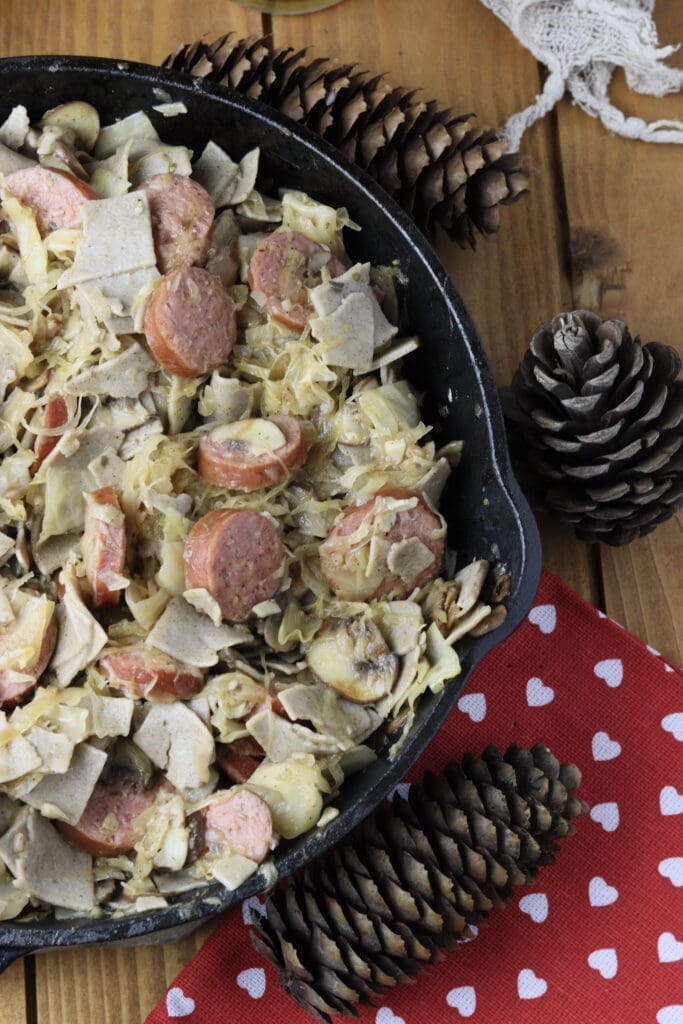
Why you’ll be making lazanki on repeat
Slavic cuisine is a treasure trove of recipes that make the most of simple, home-grown and pantry-ready ingredients. Potatoes, for example, were a staple, from which kljukusa, a delightful, heartwarming Bosnian potato pie, was made. Barley was another essential, featured prominently in Slovenia’s legendary ricet. Home-grown summer vegetables shone in sataras, a vibrant and fresh vegetable stew of the Balkans, and cottage cheese was baked in delightful Serbian cheese crescent rolls. Beef found its perfect match in the rich and hearty Polish beef goulash.
Buckwheat was probably brought to Poland around the 14th century by the Mongolian invaders and Tartars. While the famous Slovenian buckwheat bread with walnuts was made with wheat flour, lazanki, the beloved Polish noodles in our recipe, were (like buckwheat soda bread) made with buckwheat flour only. This definitely makes them stand out as the perfect gluten-free dinner.
Moreover, they can be incredibly versatile. Often, they’re cooked with ingredients available at the moment, such as fried onions and sour cream. They pair wonderfully with ground meat in a rich tomato sauce or various vegetable sauces. They are also great as pasta with mushrooms. And for those with a sweet tooth, there are delightful sweet variations of lazanki featuring poppy seeds, cream, and fruits.
Our recipe will show you how to make lazanki from scratch. Many people think making homemade pasta is time-consuming, but trust me, it’s not. And, of course, the taste of homemade pasta is much better than store-bought. These homemade noodles are actually one of the most amazing foods from Eastern Europe.
And lastly, Lazanki are also a fantastic comfort food with a nutritious and revitalizing boost. Worth mentioning, cooked with sauerkraut, they are the perfect choice and can be a lifesaver that will help you bounce back from a fun night out!
Ingredients you’ll need
BUCKWHEAT FLOUR – For the best results, it’s best to buy buckwheat flour from a local farmer or opt for organic. This significantly enhances both the taste and nutritional value of homemade pasta.
EGGS -The recipe calls for two eggs. Consider using one large egg for 100 g of buckwheat flour.
SAUERKRAUT – Sauerkraut adds a delightful tanginess to lazanki and infuses the pasta with a slightly sour flavor.
FRESH CABBAGE– Its tender leaves pair great with buckwheat square noodles and add some freshness and sweetness to the dish.
SMOKED SAUSAGES – We cooked three smoked sausages for our lazanki recipe, but you can use fewer or skip them altogether. Homemade sausages purchased at the market have an undeniably superior taste to those from the store.
SMOKED BACON – Adding slices of smoked bacon to lazanki brings a hint of smokiness and that warm-as-a-hug comforting taste we all love. Unless you’re a vegetarian, don’t skip this one!
MUSHROOMS – We were cooking lazanki in spring, so we used fresh brown button mushrooms in this recipe. However, the pasta will taste absolutely amazing if you replace these with fresh porcini or other foraged mushrooms.
AN ONION – The recipe used one large onion. Chopping an onion into small pieces gives the lazanki depth and subtle sweetness. The onion caramelizes slightly as it cooks, infusing the sauce with its savory aroma.
OLIVE OIL – This is not a must, but cold-pressed organic olive oil will enrich the dish with nutrients and beautifully complement other ingredients. Sometimes, oil was replaced with lard.
GARLIC – Three to four cloves of garlic will be sufficient to add some garlicky smell to your pasta.
PAPRIKA – Yes, a little bit of dry paprika doesn’t hurt! And just a hint – organic paprika does taste better.
MARJORAM – This herb boasts a strong aroma and subtle flavor, perfect for enhancing dishes with depth without dominating their taste.
BAY LEAF – Bay leaves cooked with sauerkraut prevent gas and bloating, especially for people who have digestive problems.
SALT & BLACK PEPPER – Add to taste. Black pepper should be added before the end of cooking.

How to make lazanki from scratch
MAKING THE PASTA
STEP 1: While you’re making the pasta, boil the sauerkraut with a bay leaf in a medium pot for 20 minutes. Do not add salt since sauerkraut is already salty. Also, bring a large pot of water to a boil and cook the sausages for about 15 minutes. Once cooked, set both aside until you mix them with other ingredients.
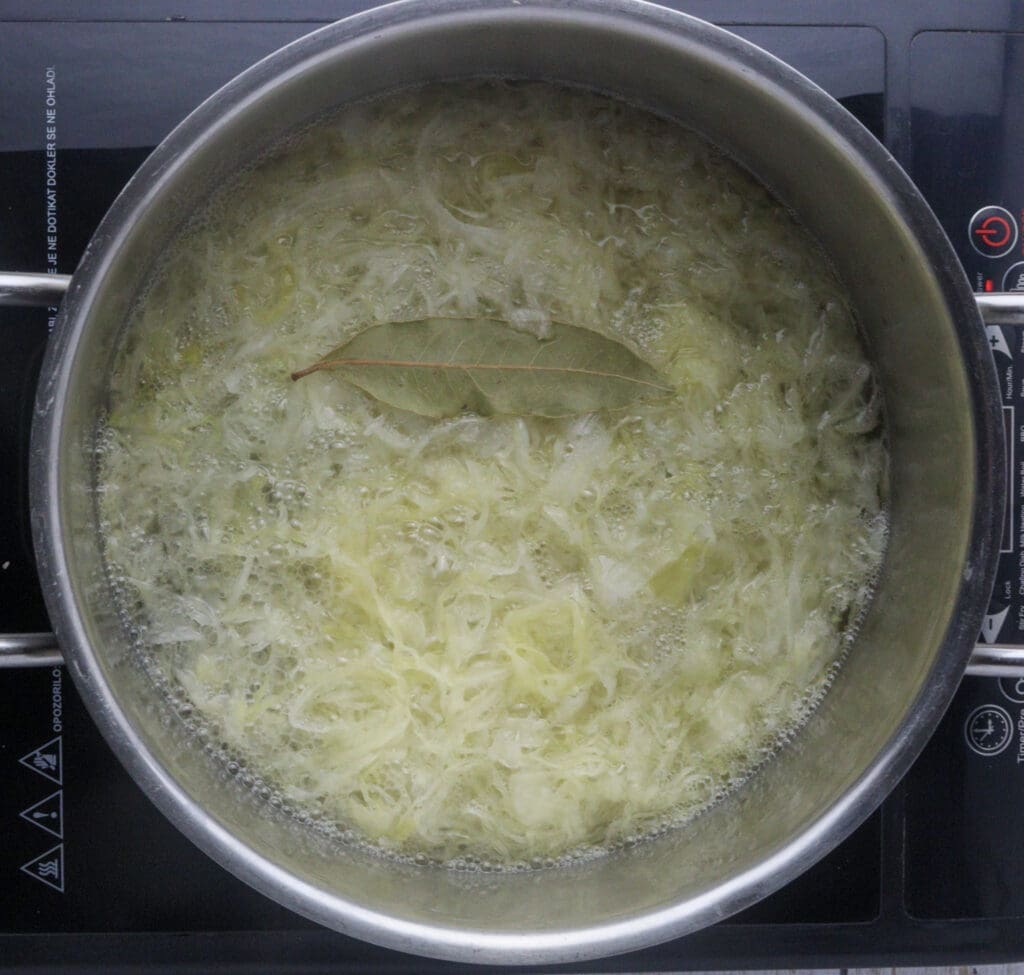
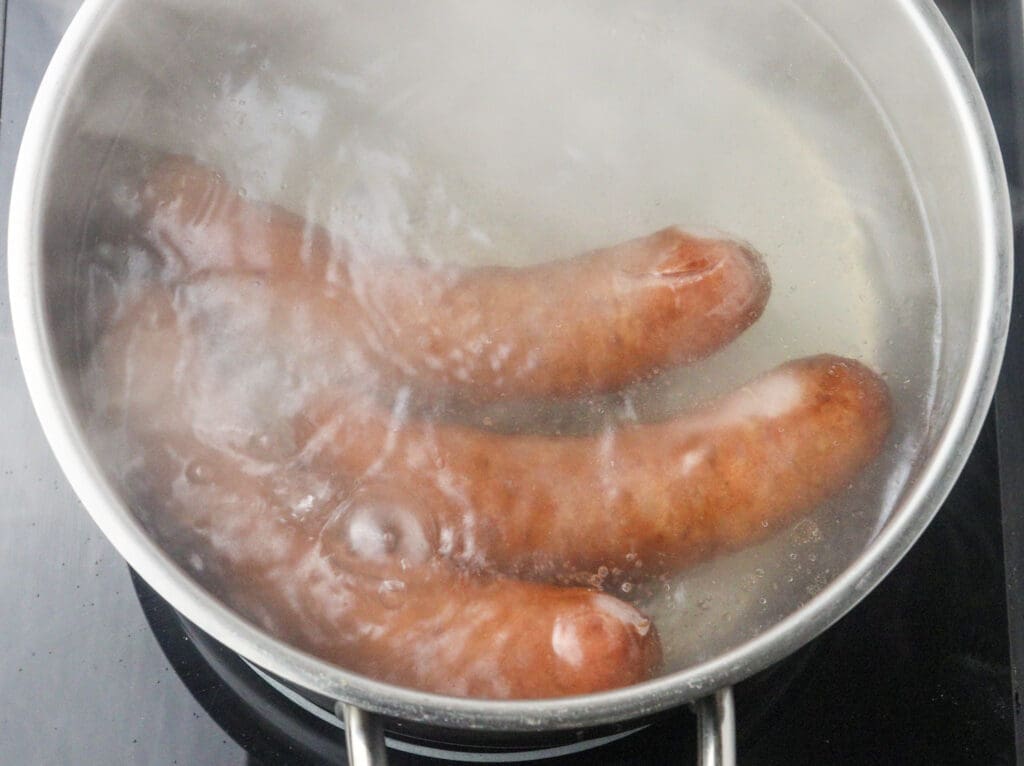
STEP 2: Whisk two eggs in a bowl. Add the flour and gently mix it into the egg mixture.

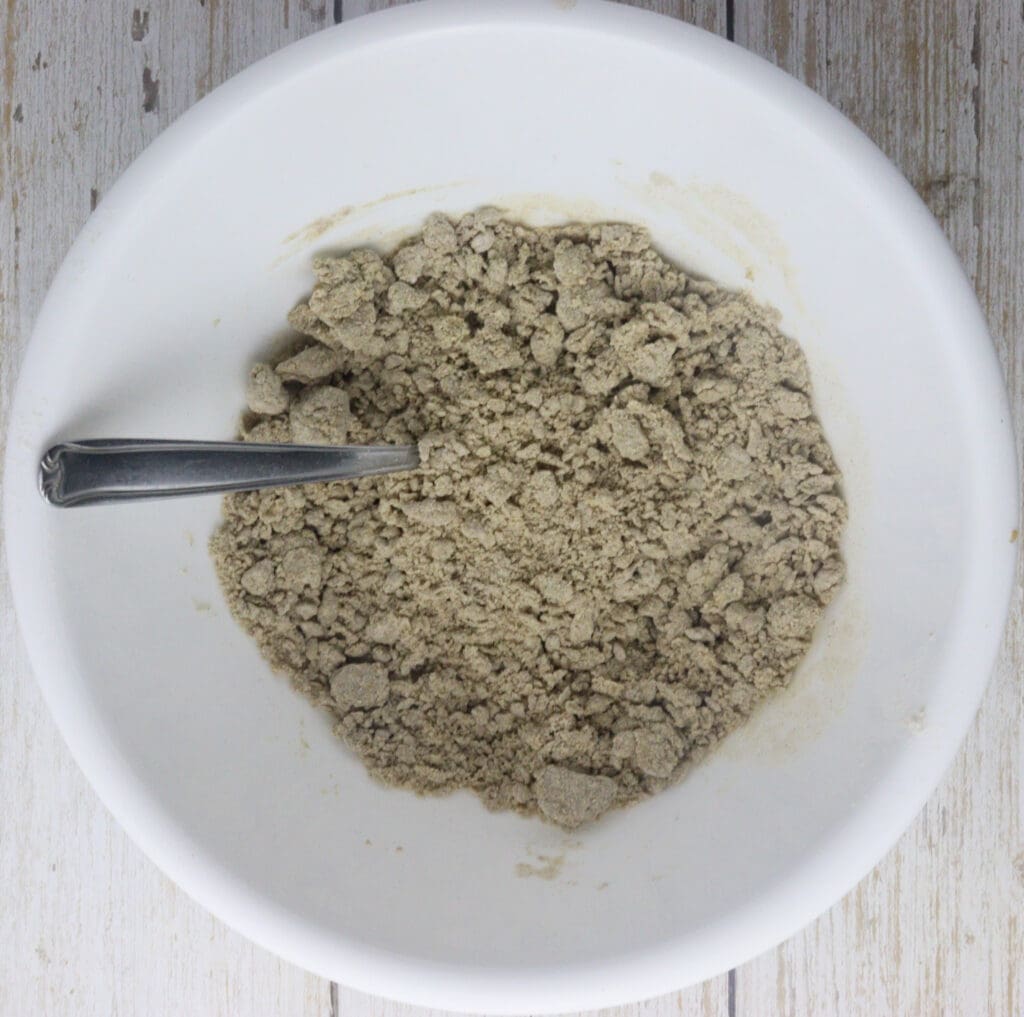
STEP 3: Start kneading the dough until it forms a rough, shaggy ball. Transfer it to a clean and floured flat surface.
Alternatively, you can use a food processor or a bread machine set to the kneading program to make it easier.
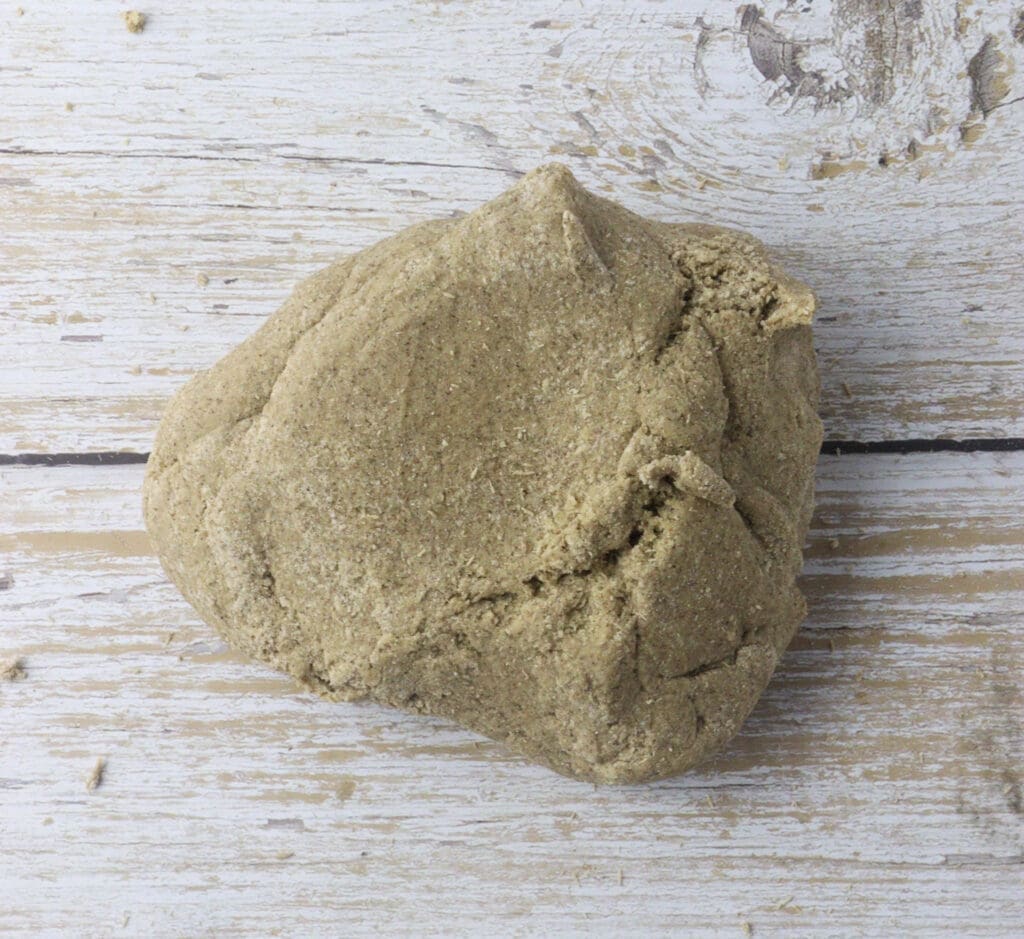
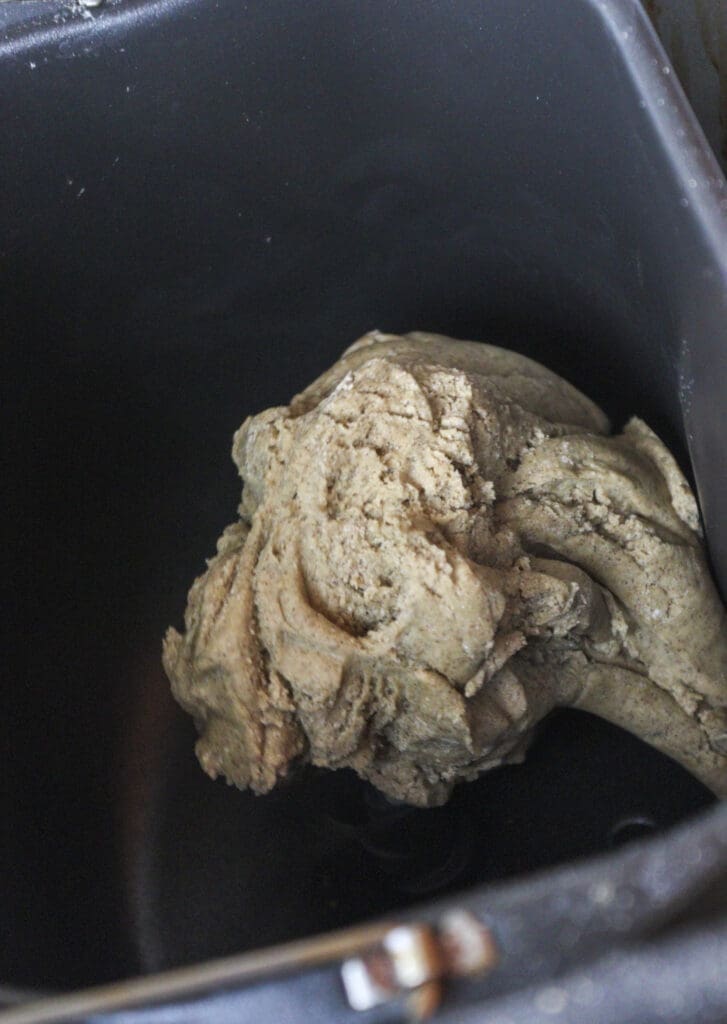
STEP 4: Knead the dough for at least eight minutes until it gets soft, cohesive and smooth. If the dough is too dry, add a tablespoon of water; if it gets too sticky, add more flour.
STEP 5: Wrap the dough with plastic wrap and let it rest for 15 minutes.
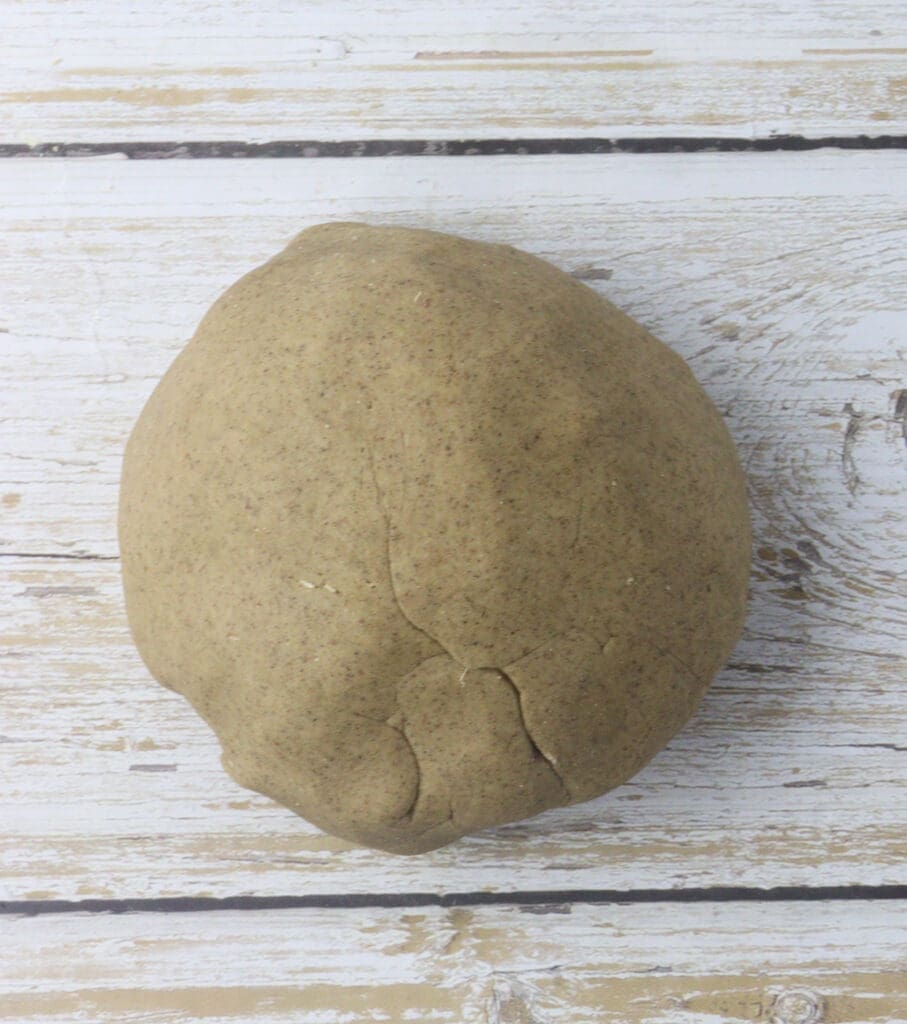
STEP 6: After the dough has rested, divide it into four pieces. Sprinkle your kitchen counter generously with flour, and roll each piece out using a rolling pin to a desired thickness. Make sure you roll out the dough evenly.
STEP 7: Cut the dough into square noodles of a preferable size using a pizza cutter or a sharp knife. Not all the cuts will be straight, but don’t worry – even if they aren’t perfect, they will taste delicious when cooked!
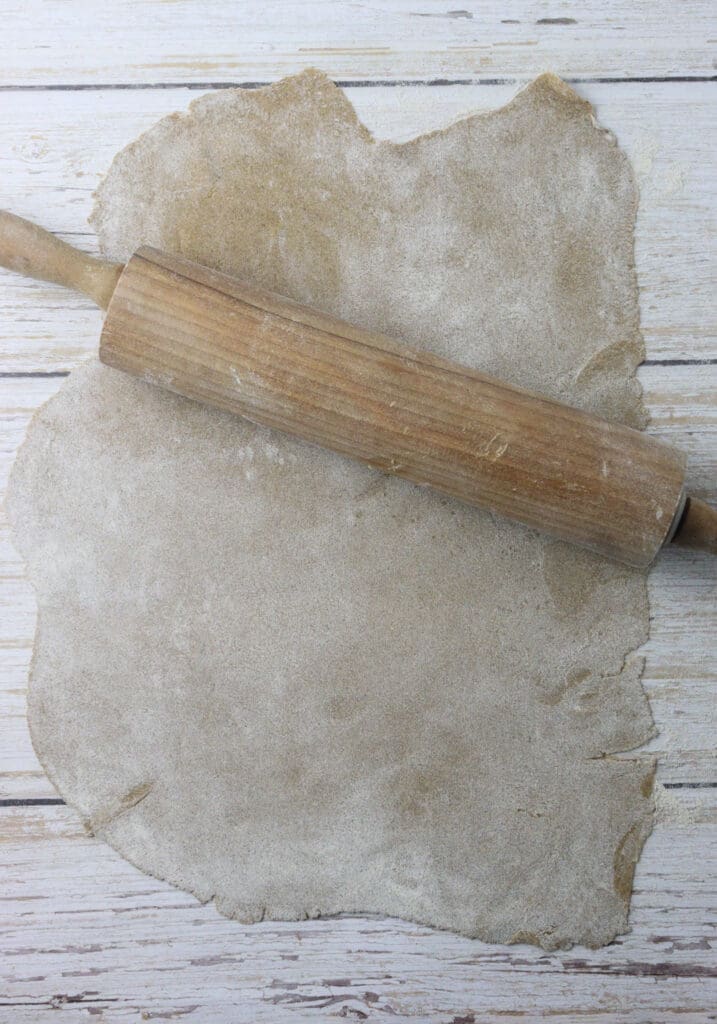
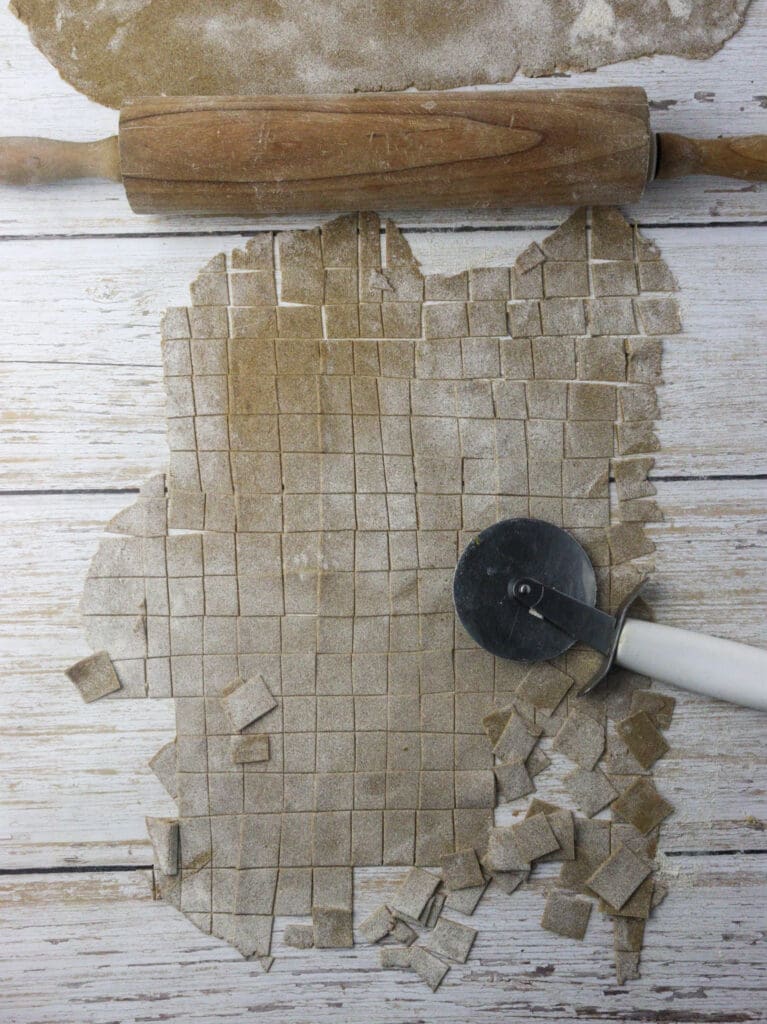
STEP 8: Prepare a clean kitchen towel, sprinkle it generously with flour and transfer the lazanki using a turner. When you reload all the lazanki, sprinkle them with flour again to prevent them from sticking together before cooking.

COOKING LAZANKI AND MAKING THE SAUCE
STEP 9: Slice the onion and garlic into pieces as small as possible, and dice the cabbage into smaller squares. Wash your mushrooms and slice them into thinner slices. Do the same with smoked bacon.
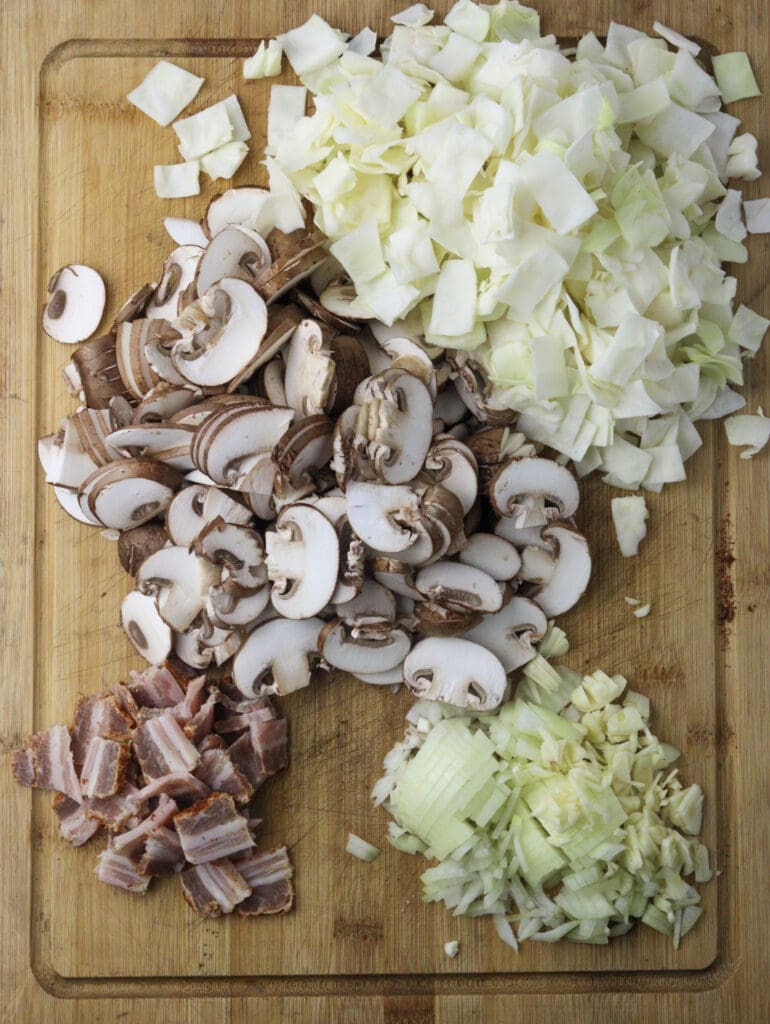
STEP 10: In a large frying pan, saute the onions and garlic in hot oil on medium heat for a couple of minutes until they start getting that nice brown color and become tender and translucent.
STEP 11: Add sliced bacon to the pan and saute for 2 minutes longer.
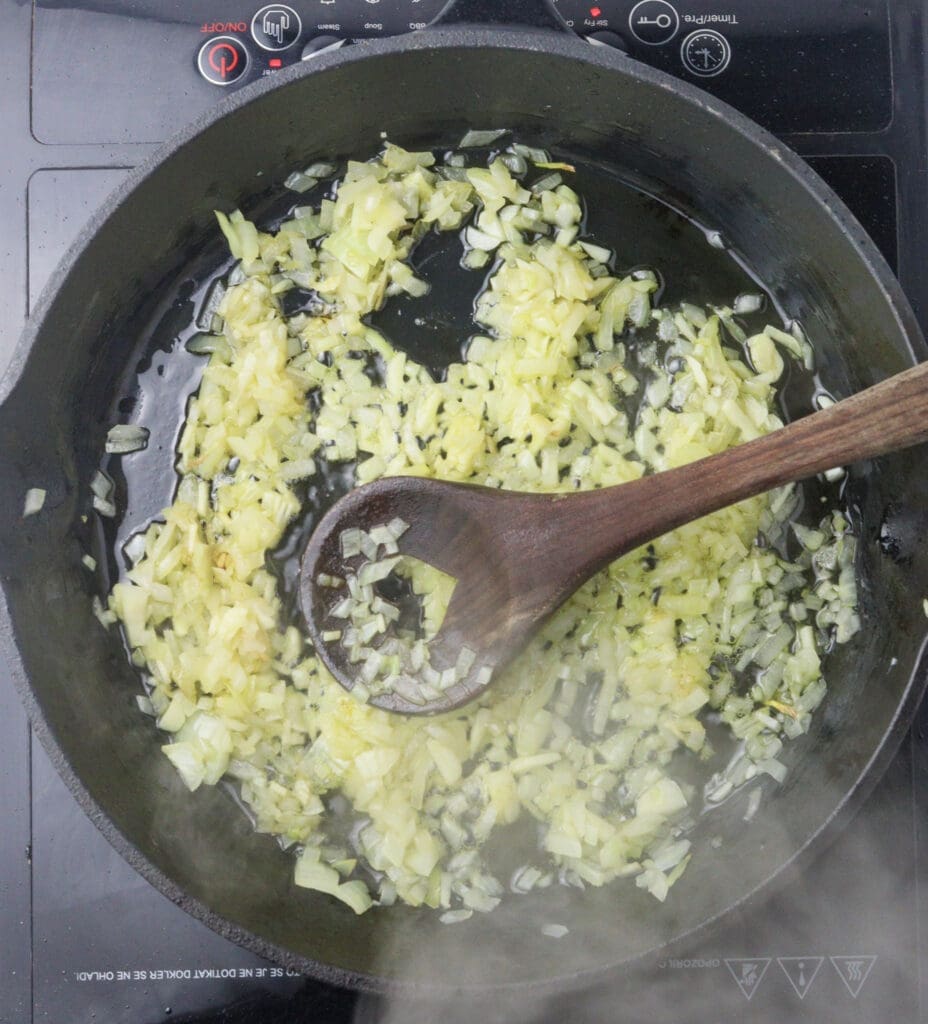
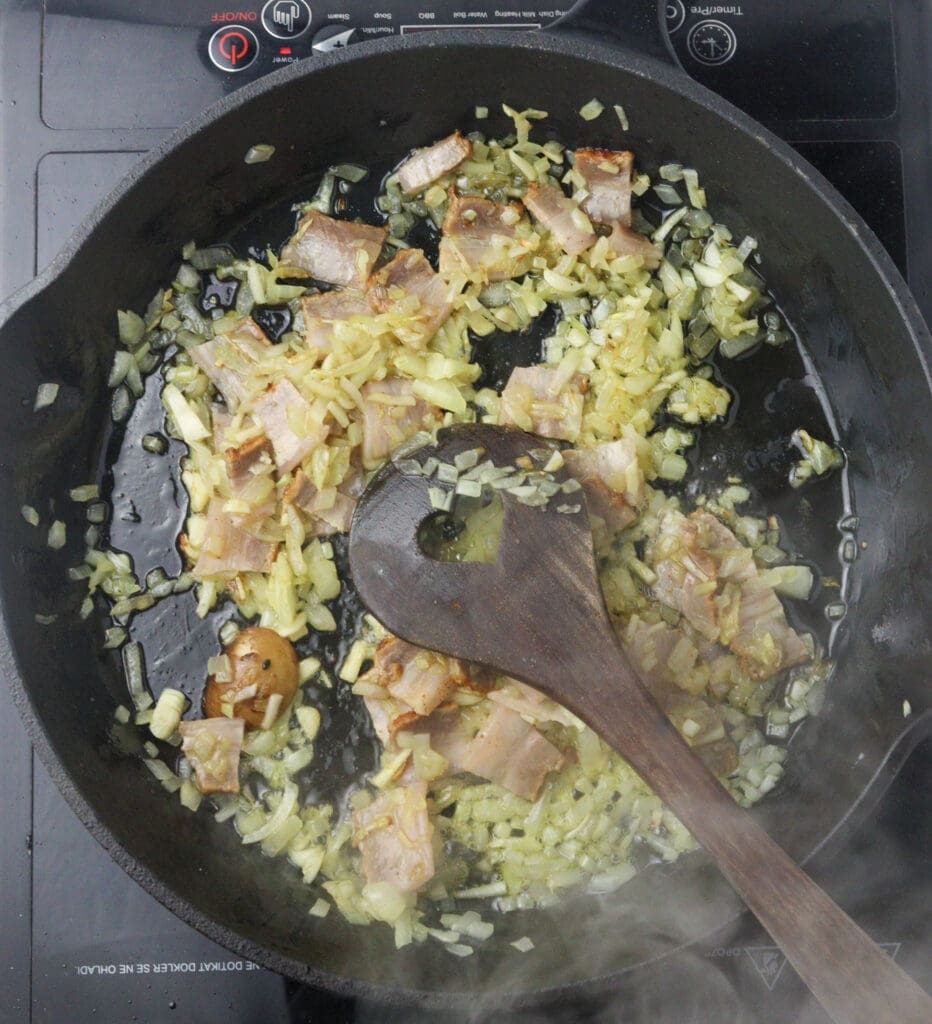
STEP 12: Add fresh cabbage and mushrooms to the pan. Sprinkle with a teaspoon of salt, dry paprika and marjoram. Stir gently several times so that all the ingredients combine perfectly.
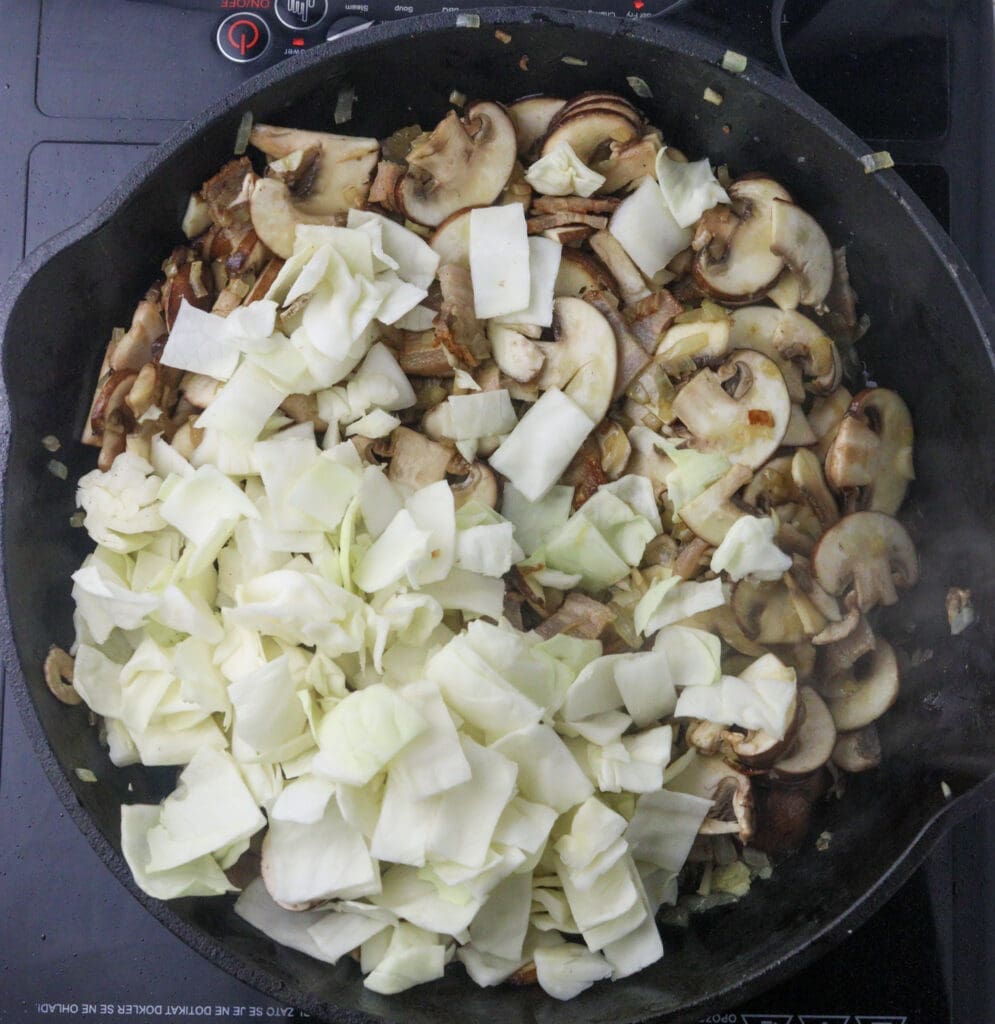
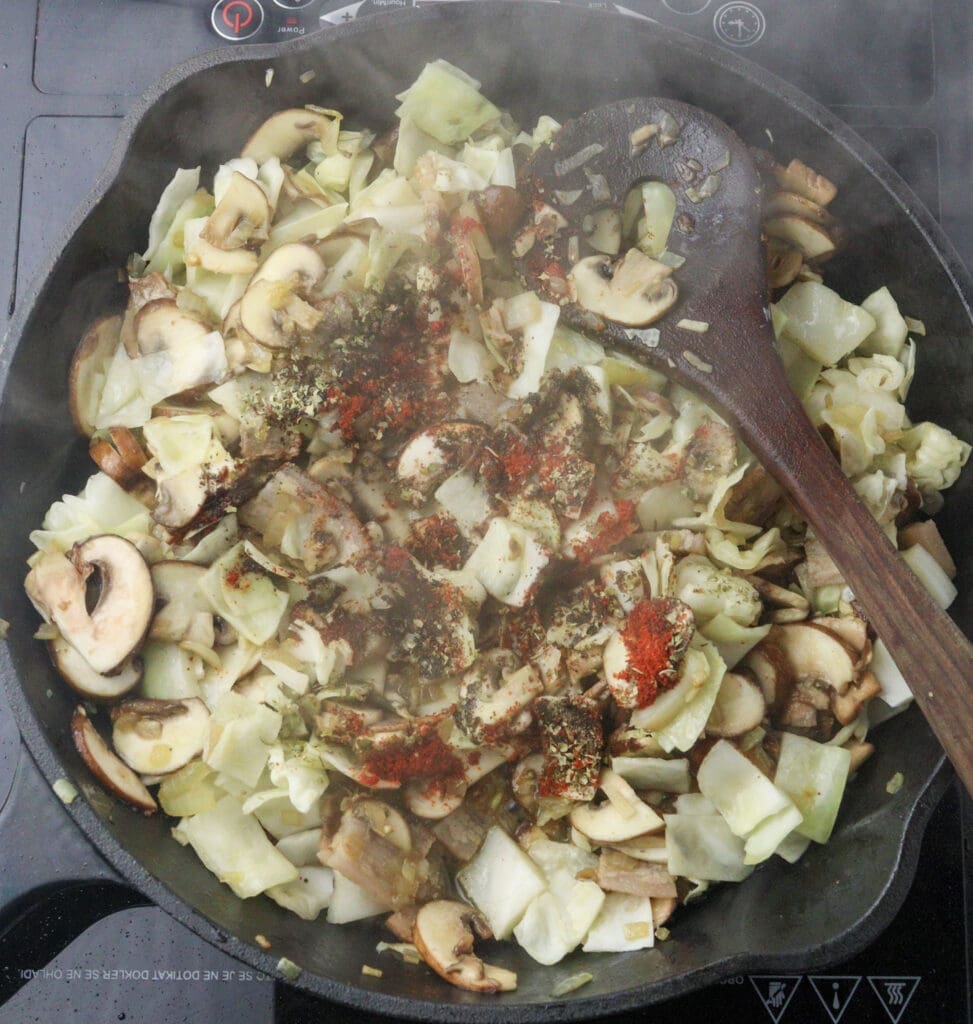
STEP 12: Add half a cup of water or soup broth and cook the dish on medium-low heat for about 15 minutes. Ensure the pan is covered with a lid.
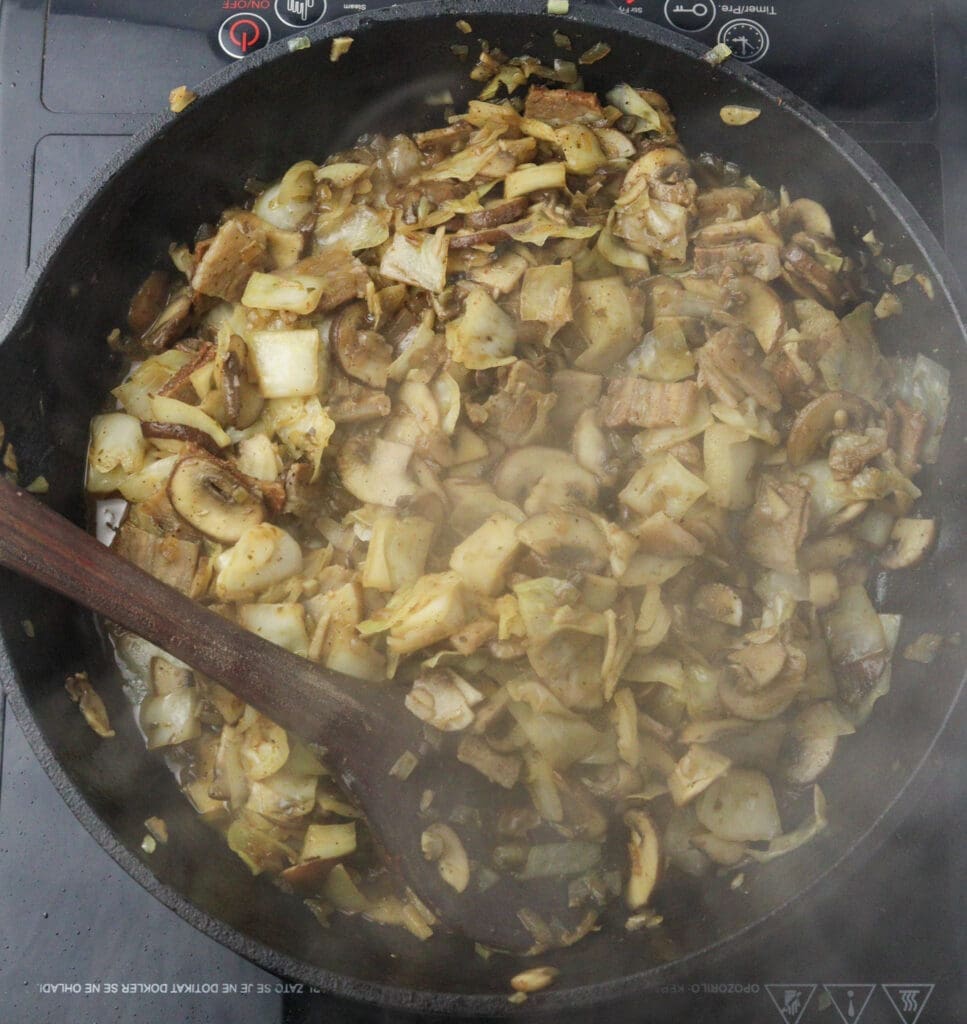
STEP 13: While cooking, cut the sausage into thinner slices and drain the sauerkraut. Remove the bay leaf. Add both sliced sausage and sauerkraut to the pan and stir until all ingredients combine. Add black pepper and cook for an additional five to ten minutes.
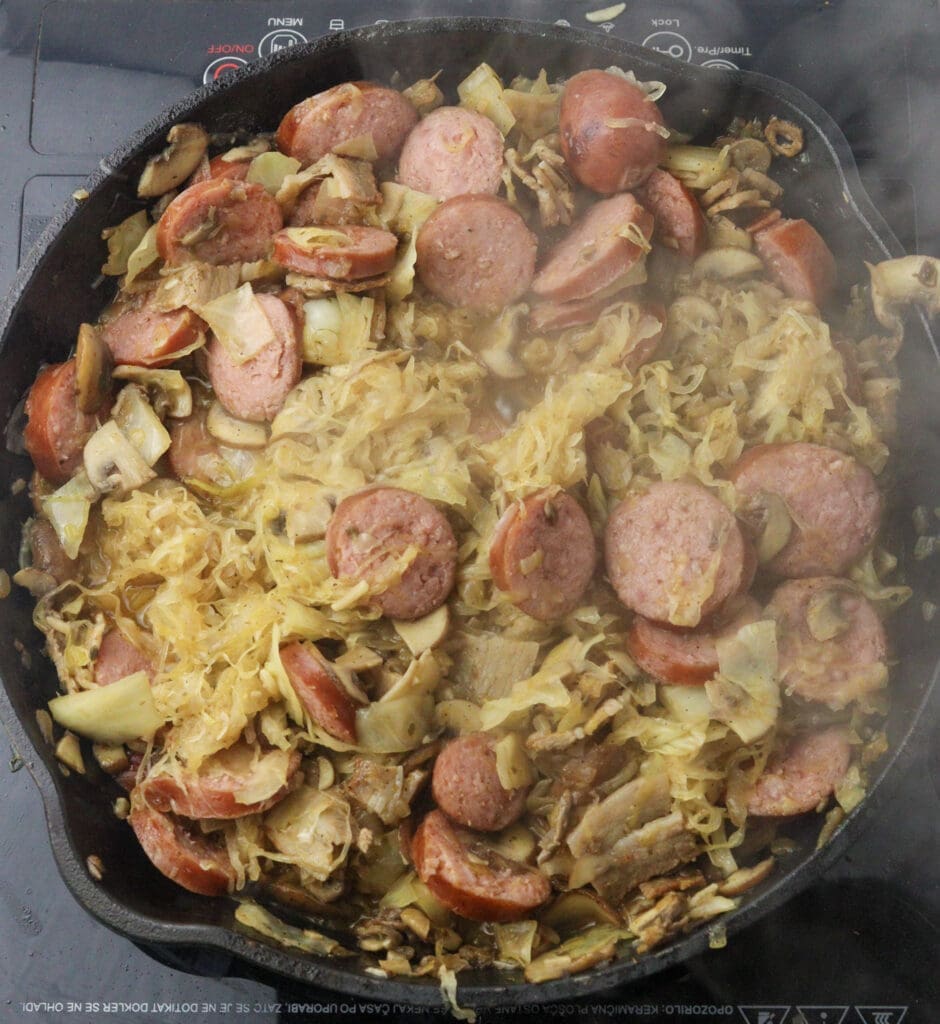
MIX IT ALL TOGETHER
STEP 14: Bring a large pot of water to a boil and gently transfer your lazanki to the pot. Cook for about 3-4 minutes. Remember, homemade pasta needs a much shorter cooking time than store-bought.

STEP 15: When cooked, drain the lazanki and add them to the sauce. Mix it together gently so all the ingredients fuse into a delicious dish.

STEP 16: Before serving, you might want to try it and sprinkle it with additional salt and black pepper to taste. Serve while still hot with a glass of good wine or tea. Enjoy!
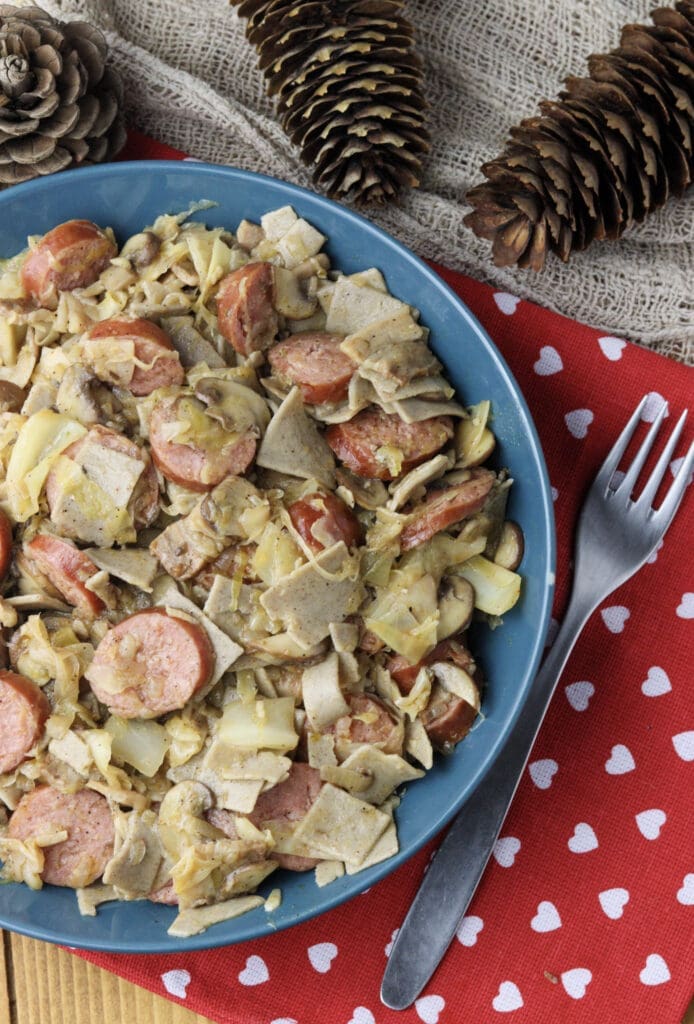
Tips worth remembering
TIPS FOR LAZANKI
- Choose quality ingredients. Use organic free-range eggs and, if possible, organic buckwheat flour.
- Ensure eggs are at room temperature for even dough mixing.
- Knead the dough well for a smooth and elastic texture.
- Rest the dough. Let it rest for at least 20 minutes, wrapped in plastic wrap.
- Flour generously. Sprinkle flour on both sides of the pasta when rolling it out and on your work surface to prevent sticking. Sprinkle with flour when
- Roll out the dough evenly for uniform cooking.
- Cook briefly. Fresh pasta cooks in 2-4 minutes. Taste it to ensure it’s al dente.
- Prepare a larger batch of lazanki. Dry them on a floured kitchen towel (they need about 48 hours to dry) and store them in a dry place.
- Use store-bought lasagna sheets. If you’re in a hurry or too lazy to make fresh noodles, quickly dip those lasagna sheets in boiling water and cut them into rectangle lazanki pasta.
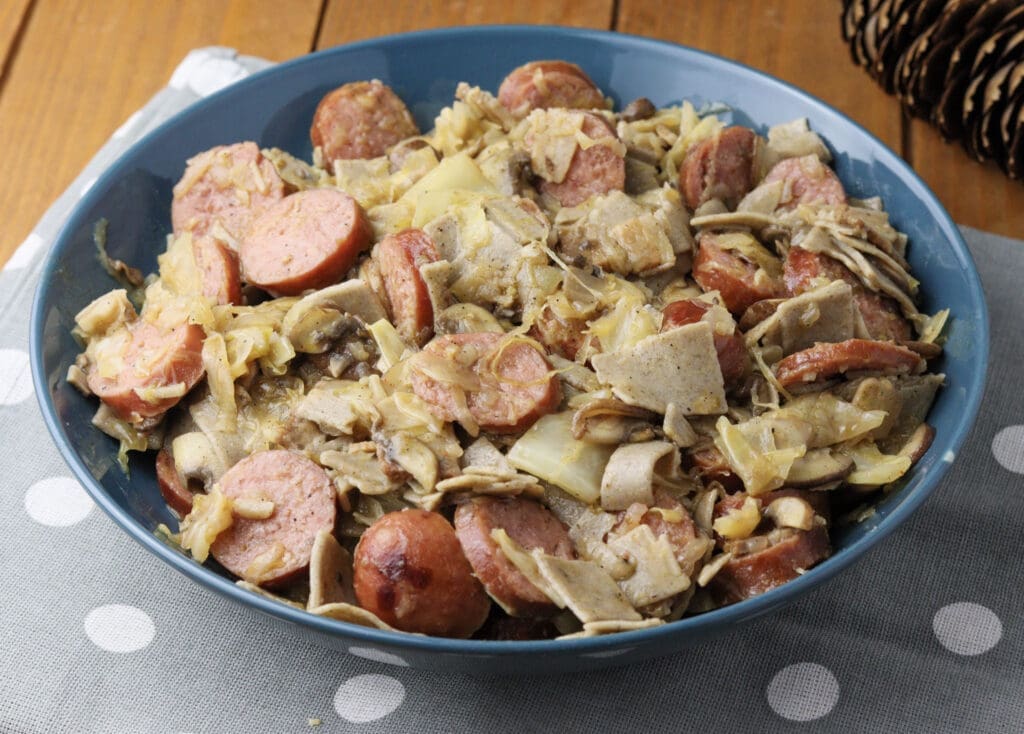
TIPS FOR THE SAUCE
- Use wild mushrooms. To enhance your lazanki sauce, use wild mushrooms like porcini, chicken of the woods or chanterelles. This will be the best pasta you’ll ever eat!
- Opt for homemade smoked meat. Homemade smoked bacon and sausages will make your dish taste incomparably better than the ones bought in the store. Yes, they might be more expensive, but they will elevate your dish, and most often, they don’t contain additives like sodium nitrate.
- Cook sauerkraut with a bay leaf. A bay leaf will prevent gas and bloating, especially for people with digestive problems.
- Make it vegetarian. Lazanki sauce will still taste great if you skip smoked meat and add beans instead of sausages.
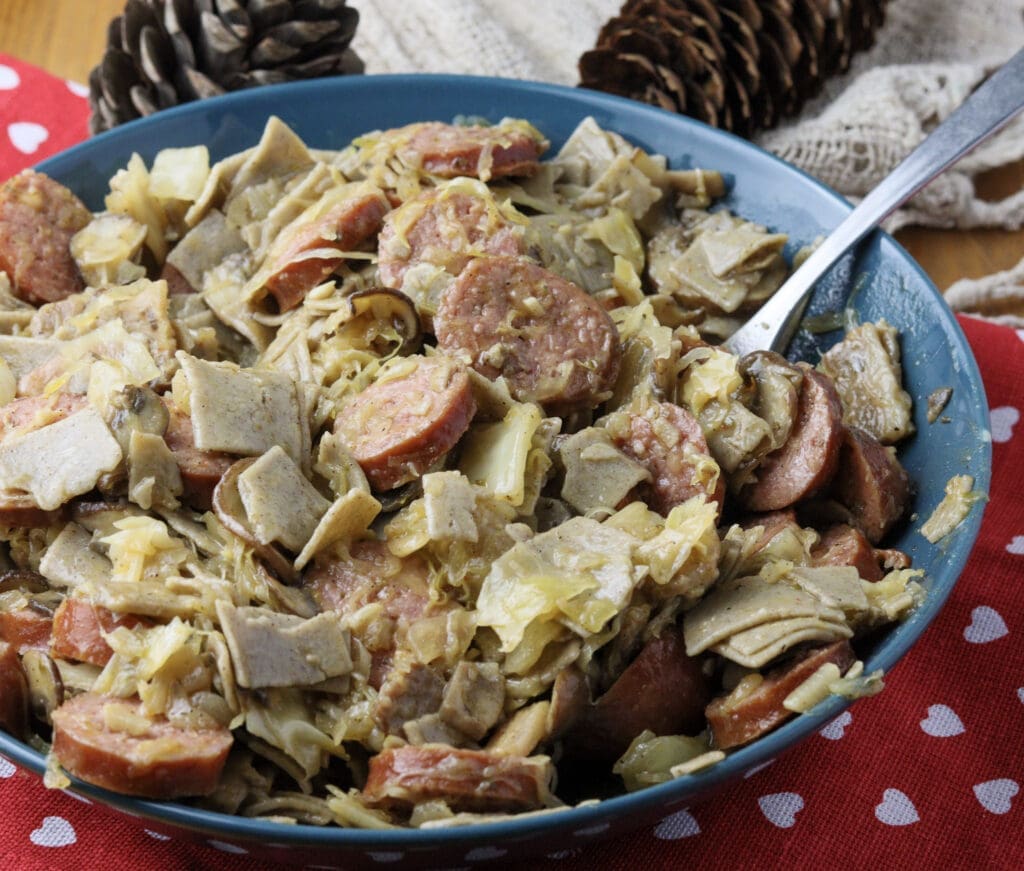
How to store them
True lazanki enthusiasts should consider making the lazanki dough in advance and storing it in the fridge. If stored in a covered container, plastic bag, or plastic wrap, it keeps well for up to four days.
You can also store fresh noodles in an airtight container in the fridge for up to 3 days. Sprinkle them with plenty of flour to prevent them from sticking together. For longer storage, freeze the noodles for up to 6 months. No need to thaw before cooking, but they might need an extra minute of boiling.
Noodles can also be dried. Dry them on a clean kitchen towel generously sprinkled with flour and store them in a paper bag in a dry place.
Lazanki cooked with sauce can be stored in a refrigerator for a day. Don’t freeze!
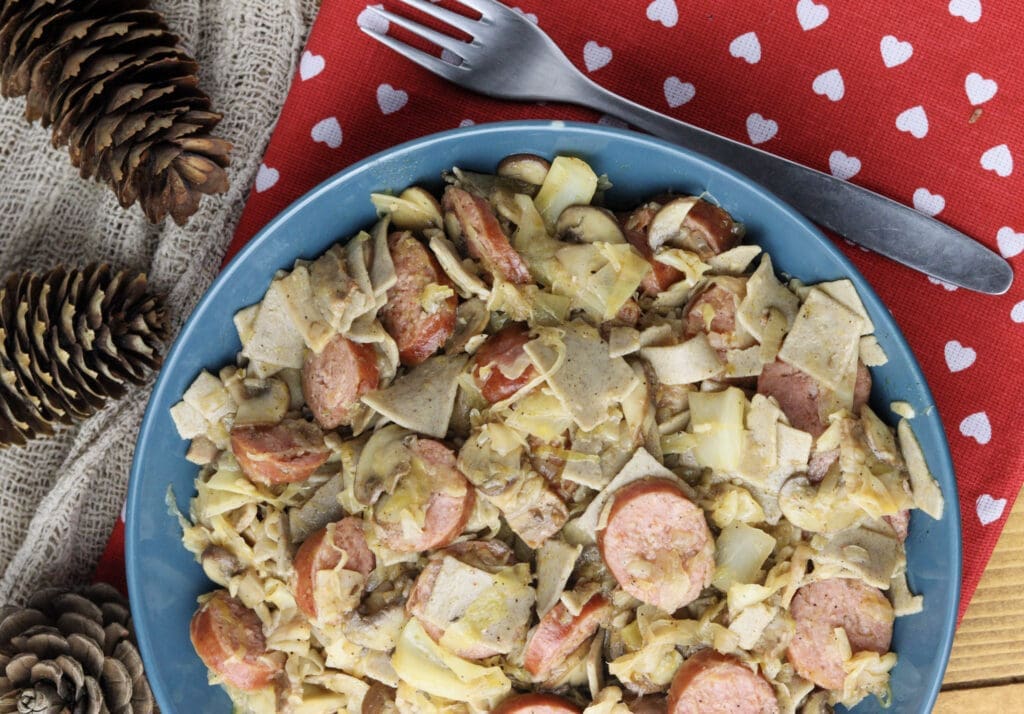
Łazanki FAQs
Lazanki is a Polish dish, while haluski is commonly cooked in Slovak, Czech, and Hungarian cuisines. Halusky is a Slovak name for lazanki.
Certainly! Be mindful that buckwheat flour absorbs more liquid when making pasta due to its high fiber content and the presence of complex carbohydrates. These have a greater capacity to retain water compared to wheat flour. However, because all-purpose flour contains gluten, it will be easier to knead the dough and roll it out.
That depends on the type of flour used. All-purpose flour lazanki contain gluten, while buckwheat lazanki are gluten-free.
Absolutely! You can replace the eggs in the dough with a liquid vegan egg substitute, usually made from mung beans.
No, lazanki sauce usually contains mushrooms that can’t be reheated. Reheating mushrooms can break down the proteins, potentially upset your stomach and cause digestive problems.
Food nutter’s Slavic recipes
Pasta dishes you might like
Tagliatelle with porcini mushrooms
Lazanki
EQUIPMENT
- Rolling Pin
- Pizza Cutter
INGREDIENTS
- 1,5 cup buckwheat flour (200 g)
- 2 eggs
- 2,15 oz smoked sausage (300 g)
- 3,5 oz smoked bacon (100 g)
- 9,5 oz sauerkraut (270 g)
- 8,5 oz fresh cabbage (240 g)
- 7 oz mushrooms (200 g)
- 1 onion
- 4 cloves garlic
- ½ tbsp olive oil
- salt
- black pepper
- dried sweet paprika
- marjoram
INSTRUCTIONS
- Bring water to a boil in two pots. In one, cook sauerkraut with a bay leaf for 20 minutes, and in another, boil the sausages for 15 minutes.
- Whisk two eggs and gently mix them into the flour. Add a pinch of salt. Knead until getting a rough, shaggy ball of dough. Transfer it to a floured surface and knead for at least 8 minutes.
- Cover the dough with a plastic wrap and rest for about 15 minutes.
- When rested, divide it into four even pieces. Roll out each piece on a clean, flour- sprinkled surface to a desired thickness.
- Cut the dough into rectangular noodles using a pizza cutter or a sharp knife. Transfer lazanki to a clean kitchen towel, generously sprinkled with flour and repeat the process for each fourth of the dough.
- Dice the onions and garlic into small pieces. Wash and slice the mushrooms and cabbage, too. Do the same with bacon.
- In a large pan, saute the onions and garlic over medium heat. Add sliced bacon and saute for two minutes longer.
- Add fresh cabbage and mushrooms to the pan. Sprinkle with salt to taste, together with dry paprika and marjoram. Gently stir and add half cup of water. Cover the pan with a lid and cook for about 15 minutes.
- Cut the sausage into thinner pieces and drain the sauerkraut. Add both to the pan and stir until all ingredients combine. Add black pepper and cook for another 10 minutes.
- In the meantime, bring a large pot of water to a boil. When the sauce is done, transfer lazanki to the pot and cook for about three minutes.
- When cooked, drain the noodles and add them to the sauce. Gently stir until all the ingredients fuse together perfectly. Try your lazanki and add more salt and black pepper if needed.
- Serve while still hot with a glass of good wine or tea and enjoy!
Video
NOTES
- Opt for organic free-range eggs and, if possible, organic buckwheat flour.
- Knead the dough thoroughly for a smooth and elastic texture. Wrap it in plastic wrap and rest for at least 20 minutes.
- Sprinkle flour on both sides of the pasta and your work surface to prevent sticking, and roll out the dough evenly for uniform cooking.
- Fresh pasta cooks in 2-4 minutes. Taste it to ensure it’s al dente.
- Dry lazanki on a floured kitchen towel for about 48 hours and store them in a dry place.
- If you are short on time, use store-bought lasagna sheets. Quickly dip them in boiling water and cut them into rectangles for lazanki noodles.
- Enhance your lazanki with wild mushrooms like porcini, chicken of the woods, or chanterelles for exceptional flavor.
- Choose homemade smoked meat. Homemade smoked bacon and sausages offer superior taste without additives.
- Cook sauerkraut with a bay leaf. Adding a bay leaf can help reduce gas and bloating.
- Substitute smoked meat with beans for a delicious vegetarian version of lazanki.
NUTRITION
Proudly announcing our lazanki were featured at Angie’s Fiesta Friday!
If you liked our recipe, please rate it in the comments below.
Show your love by sharing ❤️


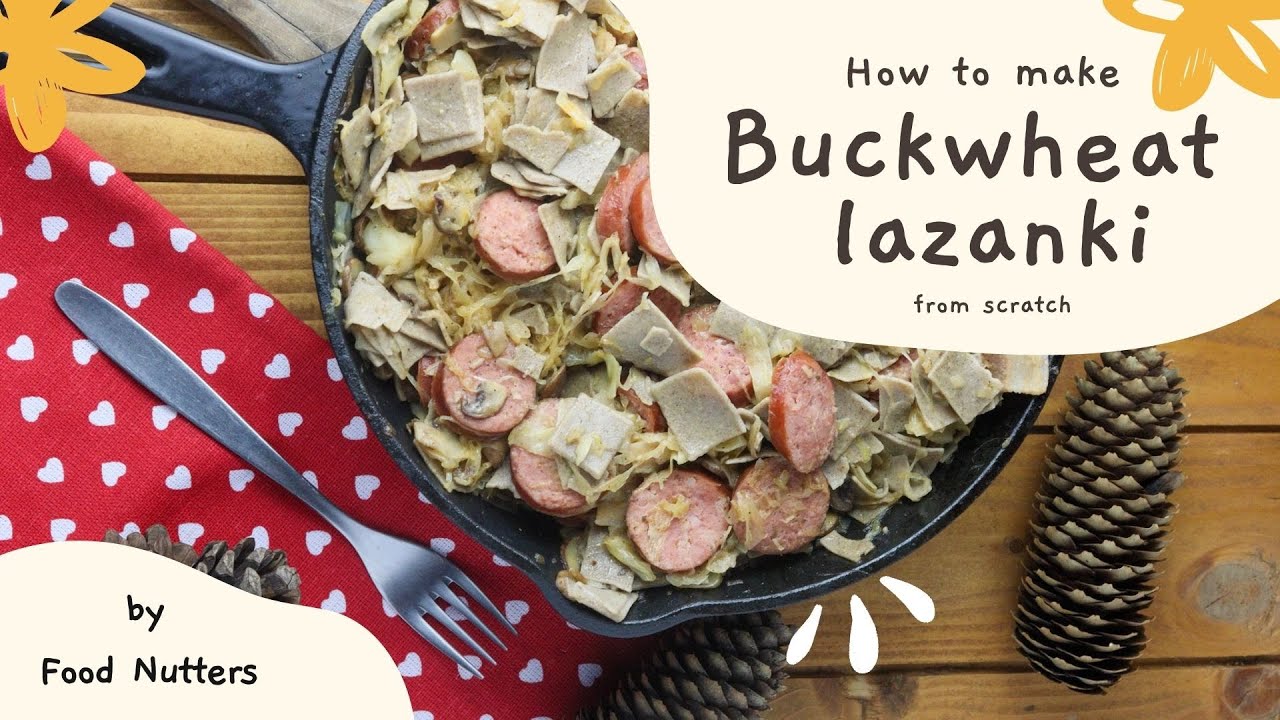
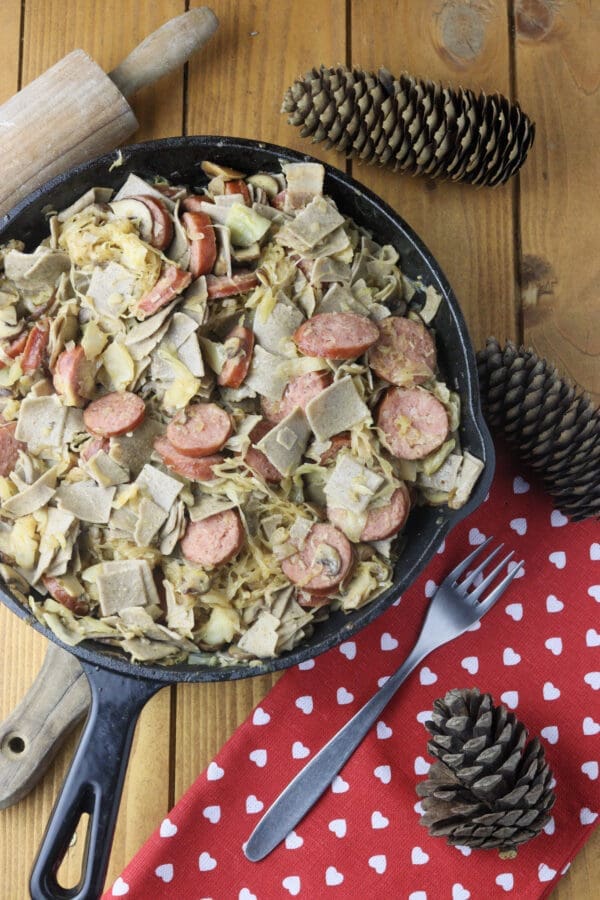
Looks like such a hearty dish!
Thanks Michele, it is! It’s so comforting and hearty, no wonder it’s so popular in Poland. I think this is the best pasta I’ve ever eaten.
The dish looks delicious – I love learning about food traditions, different foods, and how they came to be. Thanks for sharing at the What’s for Dinner party! Have a wonderful week.
Thanks Helen! I hope you’ll try these, you’ll be surprised how good they taste 🙂 Wishing you a great week too!
This is a totally new and very interesting dish. Never heard or read of it before. Very interesting and great to learn new food recipes from other cultures and coutries..
I totally agree it’s interesting. I never thought to eat pasta with sauerkraut, but once you try lazanki, you want to eat that over and over again. Definitely the best pasta recipe we ever made.
It is so rare to find original recipes. Thanks for sharing this delicious one.
Thanks Bernadette, I reckon it’s all about blending those classic ingredients with a twist of something unexpected. The taste of buckwheat noodles with sauerkraut is so much better than the regular pasta.
Thank you so much for sharing your recipe with us at Talking About it Tuesdays! Pinned. 🙂
Thanks Joanne, comments like this really make me happy 🙂
WOW! Visiting from #alittlebitofeverything! This dish is superb, pinned for colder weather. Thanks for such great recipes, Melynda @scratchmadefood!
Thank you Melyinda, I’m thrilled that such a great cook like you likes it. Indeed it’s a great comfort food for colder weather, but I was so amazed by the taste of sauerkaut with buckwheat noodles that I had to post it sooner 🙂
This looks very delicious. And your images are lovely. Very nice.
Thank you for sharing!
https://gmasphoto.website/categories/linkup-parties/
Thank you so much for your kind words! I’m really happy to hear that you enjoyed the images and found the dish enjoyable.
I love a hearty recipe! I can only imagine the lovely aroma that fills the home while preparing this delicious dish. Thank you for sharing your recipe at The Crazy Little Lovebirds link party #42. ♡ We hope you will join us again soon.
Thanks Stephanie, I hope we convinced you to try them out.
Pinned! Can’t wait to make this. It looks delicious!
I’m really happy to hear that! If you use a food processor to knead the dough they are done in minutes. I’ve got a few miles of driving to the first market, so I wouldn’t even bother to go, it’s much quicker to make them. Let me know how they worked out for you!
it is the perfect recipe! I am from Poland and it was the favourite meal of my childhood 🙂 the only difference was using ready-made pasta 🙂 thank you for great reminder 🙂
Awww, thank you! Yes, I was looking for ready-made lazanki noodles in the supermarket here some time ago and I couldn’t find them. So I was thinking what the heck, let’s just make them. And honestly, if you have something that kneads well (like a stand mixer or bread machine) it only takes minutes to roll them out. Plus, you can save the dough in the fridge. I am so happy that you liked the recipe!